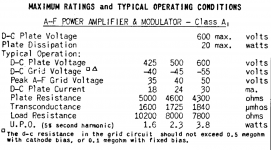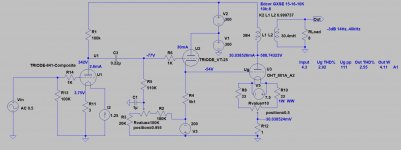Thanks Andy, you're making my life real easy 🙂 I'll build the filament supplies in a separate chassis as you recommended.
Would you have a ballpark schematic on hand for DC cathode bias of the output stage? That's the only building block that's still missing.
Or I can just check it myself and propose a schematic.
I do realize I'm being spoiled
Thanks man!
Cheers
Simon
Would you have a ballpark schematic on hand for DC cathode bias of the output stage? That's the only building block that's still missing.
Or I can just check it myself and propose a schematic.
I do realize I'm being spoiled

Happy Trails!
Thanks man!
Cheers
Simon
Great, the greenvalve operating point looks reasonable (570v / 30mA / 48v) and I'll probably use it as a starting point. I'll be sure to keep an eye on the grid resistor.
Cheers
Cheers
For this operating point even the -resistor loaded- 841 gain is too weak (see attached simulation).
If you use active load (CCS or "gyrator" -see Ale Moglia versions-) the 841 VAS stage gain would be greater for full amplification at 2V RMS input.
If you use active load (CCS or "gyrator" -see Ale Moglia versions-) the 841 VAS stage gain would be greater for full amplification at 2V RMS input.
Attachments
Thank you Euro21. Once I've improved my skills with the greenvalve build, your circuit with 841 ccs/gyrator load, source follower and A2 output is a logical next candidate. Keen to put those 841 to work!
Last edited:
Soft start
For extended tube life, I would like to implement soft start wherever I can.
Is this sound?
- Separate switch on Coleman regs (which have a built in slow start IIRC), to be fired up first
- A minute later I'ld switch on SMPS B+, feeding:
> tentlabs negative bias supply on the output tubes (with built in slow start)
> driver tubes, with filament bias as per post 19
Is there a way (or necessity) to apply slow start to the driver tubes as well?
Thanks!
Simon
For extended tube life, I would like to implement soft start wherever I can.
Is this sound?
- Separate switch on Coleman regs (which have a built in slow start IIRC), to be fired up first
- A minute later I'ld switch on SMPS B+, feeding:
> tentlabs negative bias supply on the output tubes (with built in slow start)
> driver tubes, with filament bias as per post 19
Is there a way (or necessity) to apply slow start to the driver tubes as well?
Thanks!
Simon
"> tentlabs negative bias supply on the output tubes (with built in slow start) "
The negative bias must be alive before B+ available!
Any "slow start" is unnecessary.
The negative bias must be alive before B+ available!
Any "slow start" is unnecessary.
Thanks a lot Euro, I know you have the experience to back up your advice on these tubes.
I'll use two switches then: one for filaments and negative bias + a second for B+ to be activated a little later.
I'll use two switches then: one for filaments and negative bias + a second for B+ to be activated a little later.
Last edited:
Here is a link to a simple way to delay high voltage using two DPDT switches.
Audio ratbag: HV delay using two DPDT switches
ray
Audio ratbag: HV delay using two DPDT switches
ray
Thanks Ray, that's very clever.
The advantage I see is that it leaves no room for human error. But the filament Xformers with Coleman regs and B+ smps would need to be housed in the same chassis.
Would that be ok, as the smps might lead to emi/rfi?
Cheers
Simon
The advantage I see is that it leaves no room for human error. But the filament Xformers with Coleman regs and B+ smps would need to be housed in the same chassis.
Would that be ok, as the smps might lead to emi/rfi?
Cheers
Simon
No, you just run two wires carrying AC (240 or 120) from the switches to the filament supplies in one chassis and the other two wires carrying AC (240 or 120) from the switches to the smps in the other chassis.
ray
ray
Another umbilical... That leaves me more tempted by a single switch per power chassis + some attentiveness.
I do appreciate the reflection though
Simon
I do appreciate the reflection though
Simon
I agree about the extra umbilical. Personally, I would put both SMPS and filament supply in one box and try to shield one from the other with RF shielding material and also try to put some distance between the SMPS and filament supply.
ray
ray
Since I have enough room on my rack for separate boxes, I'll probably go for one on each side of the amp. Will use wine crates, and if emi/rfi is a problem I can shield them with copper foil.
Great info on your site btw, Ray.
Simon
Great info on your site btw, Ray.
Simon
I build several amps and preamps using 10Y and 801a.Best was normal cathode bias with Rod Coleman regulators and use of ultrapath capacitor between b+ and cathode. 4.7uf is enough
Do you mean best in sound or measurements (or, imagine: both)?
I can try the ultrapath cap once I've built it, but read that the advantage is mostly to tackle psrr. I would suspect the smps would already take care of that.
But all guessing aside, I could just give it a listen.
Cheers
Simon
I can try the ultrapath cap once I've built it, but read that the advantage is mostly to tackle psrr. I would suspect the smps would already take care of that.
But all guessing aside, I could just give it a listen.
Cheers
Simon
With ultrapath you need no cathode c and you took the last power supply cap out of the signal path. I have not testet filament bias, but soundwise was ultrapath best. But you need a very clean B+ to avoid hum
I don't know how this applies to the configuration I will be using: fixed bias on output stage and smps... For the input stage I'll do filament bias as recommended.
Stacked supplies- max voltage
Dont wish to hijack thread, but can people with experience advice max voltage that can be obtained by stacking the 48v switching supplies. I was wondering if 19 could b stacked to obtain approx 900V to power a 813SE amp that I am planning to construct.
Dont wish to hijack thread, but can people with experience advice max voltage that can be obtained by stacking the 48v switching supplies. I was wondering if 19 could b stacked to obtain approx 900V to power a 813SE amp that I am planning to construct.
I used 12 of them to get +576 and 4 to get -192. Remember not to connect the grounds of the AC inputs together. See post 11.
Opinions are divided about the safety of stacking the units. Mine is that if they are wired correctly, each unit sits in its own bubble and does not 'see' the other units. You may want to look at other forums as well as this one for different opinions.
So if I wanted to build a 1000v supply, I would use stacked units. It would be simpler than dealing with the HV requirements of the chokes and capacitors, most of which are not rated for 1000v. But I don't want to build such a supply. I would be too concerned about the 1000 volts and all the associated safety problems. 600v is my limit.
By the way, I did breadboard an OTL using stacked SMPS units. They worked fine and can deliver a lot of current quite easily.
The reason why I tried the stacked units was that after my triple bypass, I could not lift amps with regular transformers and chokes. The SMPS units are so much lighter.
ray
Opinions are divided about the safety of stacking the units. Mine is that if they are wired correctly, each unit sits in its own bubble and does not 'see' the other units. You may want to look at other forums as well as this one for different opinions.
So if I wanted to build a 1000v supply, I would use stacked units. It would be simpler than dealing with the HV requirements of the chokes and capacitors, most of which are not rated for 1000v. But I don't want to build such a supply. I would be too concerned about the 1000 volts and all the associated safety problems. 600v is my limit.
By the way, I did breadboard an OTL using stacked SMPS units. They worked fine and can deliver a lot of current quite easily.
The reason why I tried the stacked units was that after my triple bypass, I could not lift amps with regular transformers and chokes. The SMPS units are so much lighter.
ray
- Home
- Amplifiers
- Tubes / Valves
- Greenvalve 10y into 801a

